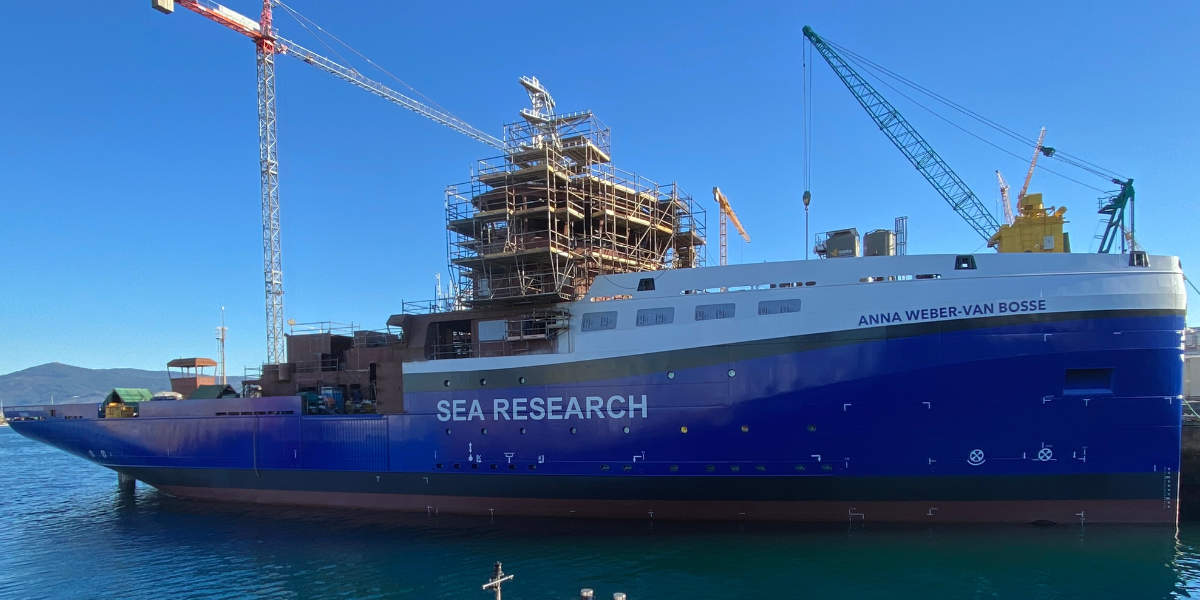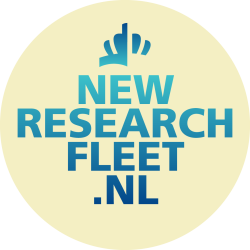Construction planning for 2025
Preparing delivery of RV Anna -Weber-van Bosse in 2025
Aarnoud van de Burgt, head of the National Marine Facilities departement and NewResearchFleet project manager, explains all the work which has to be done to deliver the RV Anna Weber-van Bosse by the end of this year.
The vessel was launched in late October 2024. What has Armon, the shipyard in Vigo, been up to since then?
After the successful launch in late 2024, 2025 will be the year of final delivery. The vessel’s final form is gradually becoming visible on the outside, but there is still much work to do on the inside.
After the launch, the hull was moored at the yard’s finishing dock. The top sections were too tall to be mounted inside the production facility, so the wheelhouse and upper decks were installed outside and the vessel was painted in the desired colour scheme. Aside from the components that would be all but impossible to add later, such as the engines and propellers, the vessel was still almost empty inside at the time of the launch. Immediately after that the yard started installing piping, cabling insulation, HVAC piping and fitting components.
Which major tasks are scheduled for 2025 to complete the vessel by the end of the year?
One massive job is the installation of all the cables throughout the vessel, which will take up most of the remaining building period. Cable ducts are being installed throughout the hull, and around 230 km of cables are being laid to connect all the systems and networks on board. Workers will also start on the interior by laying decks, installing bulkheads and wet labs, and furnishing the cabins, laboratories and server rooms. Technicians are installing all the necessary components in the engine room and technical rooms, as well as the water supply and treatment system. This involves a large number of components and connections throughout the vessel’s network.

Who is involved in the project management, and how do they approve all of the items?
First, there is the shipyard’s own project management team. They are responsible for delivering the vessel in accordance with NIOZ’ specifications. Although the specifications include hundreds of pages of details about systems and facilities, materials and finishings, there is still plenty of room for interpretation. So NIOZ has appointed a site team of specialists to closely monitor the process, advise the shipyard, inspect the work and report back to NIOZ.
This site team is led by site manager Johan Hoogerhuis, who has a wealth of knowledge and experience with shipbuilding and operations. He supervises the team, monitors the full construction process according to the specifications, including approval of all shipyard specifications and designs. He is also in constant contact with the shipyard’s own project team. Pieter Bakker is an experienced head machinist and has considerable experience in construction management. He mainly focuses on all the issues related to the technical installation in the engine room. Lorendz Boom has many years of experience as the Support Manager at the NMF within the NIOZ organization. His main focus is the deck equipment and the layout of the various spaces, from the container deck to the cabins, to facilitate operations after delivery. Verner de Bies is an experienced ship construction inspector. He also lives in Vigo, near the shipyard. Verner has been present at the yard since the earliest phases, and is responsible for all the steel construction inspections. Kees Hoogendijk is an electronic specialist who has supplied installations to the shipbuilding industry for many years. He contributes his expertise to the construction of the Anna Weber-van Bosse.
The other team members include retired Captain of the Pelagia, Bert Puijman, and Bert Hogewerf, the Pelagia’s chief machinist and crew representative. Marcel van der Linden serves as the team’s contract manager, and Gert-Jan Reichart is the project sponsor on behalf of the scientific community. He acts as a liaison between the various specialist fields to provide information needed to optimise choices for the vessel’s future scientific duties. As the NewResearchFleet project manager, Aarnoud van de Burgt monitors the overall process and serves as the site team’s point of contact within the NIOZ.
The shipyard applies the NIOZ’ design specifications to the design of the vessel, its compartments and systems, and by specifying all of the components and materials used. The yard then submits these choices to the NIOZ site team, which approves the choices or offers comments. At first, the team mainly reviewed the ship’s designs, but soon they were looking over the schematics of the various systems, and then the specifications for the shipyard’s suppliers. Most of the components have been purchased and the hull is in the water, so builders are rapidly installing insulation, decks, cables and all the instruments and interiors.

When will the vessel begin its sea trials, and how does that work?
The sea trials are scheduled for several weeks in the summer of 2025. First, all of the systems will be activated and tested while the vessel is moored to the dock, before the various trials are conducted at sea. After this the technical sea trials are held to adjust the technical systems on board so that everything works without fail and the ship does what it needs to do in terms of speed and manoeuvring. NIOZ crew will be present at these tests, in addition to the site team. The classification society will also attend these trials. The trials will also test how all the systems function while underway, especially if the systems have been properly integrated for operation from the bridge, and if they communicate properly with one another. Technical sea trials will be followed by test runs for calibration and testing of all scientific systems. Our site team will be present to observe the shipyard’s successful implementation of the sea trials protocols, together with our specialists in specific areas, such as the hydrographic specialist.
Why will the vessel also conduct sea trials in Norway?
Norway is home to a testing centre for measuring underwater sound, which is an important aspect of a research vessel and for NIOZ. The vessel must meet specific requirements for underwater noise emissions. At the testing centre, the vessel can sail along various courses in a fjord to measure whether the noise emitted meets the specifications. This test is scheduled for the end of the sea trials, after the work in Vigo is complete. The test course is a collaborative effort by the navies of the Netherlands and several other countries, and they have made it available to the NIOZ as well.
When and how will the ship be handed over officially?
Our inspectors are constantly approving parts of the project throughout the construction process. At the same time, the shipyard has submitted the necessary blueprints and specifications to the classification society, and representatives from the classification society have visited the yard to approve some crucial issues on location. Once all of the items have been approved and certified by the classification society, and the sea trials have been completed, the vessel will be transferred to the NIOZ in the second half of 2025. By that time, the crew will have arrived in Vigo, eager to get underway with the new vessel.
What will ship new ship mean for the organisation?
For the organisation, it will mean the dawn of a new era that we have all been looking forward to for a long time. The expansion to eventually 31 berths for scientific passengers, and all of the new facilities and equipment on board like the gliders, the AUV and the ROV will give a massive stimulus to the utility and added opportunities for the scientific crew to collect data and samples for their research faster, more efficiently, and with fewer emissions.
They can also collect data and samples in locations or in quantities that would have been impossible aboard the old Pelagia. For the NIOZ/NMF fleet management, it will mainly mean preparing for a new phase in which the vessel is operational, such as applying for all of the certifications and insurance policies, training the crew, procuring supplies, tools and equipment, and managing the hospitality aspects. But it will also require changes to the harbour.
And along with the other two new vessels in the fleet, it will entail a big step forward in digitising the operational and maintenance processes between ship and shore. That will mean expanding the crew, and we are looking for smart solutions using new equipment and state-of-the-art technology to take full advantage of remote access, both for the vessel and for the scientists on board, so that it can serve multiple purposes simultaneously. The same applies to the support team ashore, who prepare the voyages, those who conduct scientific research on board together with the crew, and who will have to keep learning to keep up with the changes with the new vessel and new equipment. There will undoubtedly be issues that need ironing out in the beginning. But we’re certain that our teams will be able to manage it just fine, as they all share a single focus on collaborating with and facilitating the scientific community. Or as we say at the NMF: we make, you measure.
Impression of the RV Anna Weber-van Bosse, January 2025









All photos above: Lorendz Boom, januari 2025
